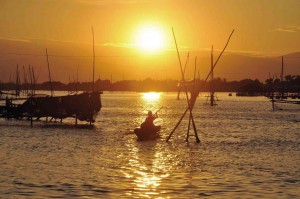Dagupan pushes drive vs illegal fish pens, cages

ILLEGALLY constructed fishing structures dot a portion of the Calmay River in Dagupan City. WILLIE LOMIBAO/CONTRIBUTOR
DAGUPAN CITY—Acting Mayor Belen Fernandez has asked the city agriculture office to clear Dagupan’s rivers of all illegal fishing structures, which have sprouted there in the last four months.
City agriculturist Emma Molina said her office has started identifying the owners of the illegal structures and their location.
“The acting mayor will also be going around the rivers on Tuesday to assess the situation,” Molina said in a radio interview.
Fernandez, who was elected mayor on May 13, took over as acting mayor last week after outgoing Mayor Benjamin Lim suffered a stroke on May 12.
At least 20 illegal fish pens and other fishing structures have sprouted in this coastal city’s western rivers in the last four months, raising alarm that fish kill could just be around the corner.
Article continues after this advertisementIn an earlier interview, Manuel Gutierrez, chief of the city government’s river and coastal protection and management office, said the pens, which are stocked with “bangus” (milkfish), will be dismantled by the end of May.
Article continues after this advertisement“For humanitarian reasons, we gave them until this month to raise their stocks and harvest them. They don’t have a place to transfer their stocks if we destroy their pens now,” Gutierrez said.
The seven rivers crisscrossing this city were cleared of fishing structures in 2010 after Lim ordered them dismantled to allow the rivers to breathe.
But Gutierrez said a few stubborn bangus growers managed to build new bamboo pens in the Talaib-Tocok area in the western part of this city early this year.
“We did not have a boat and enough manpower to regularly patrol our rivers. As you know, we rented boats when we demolished the fishing structures three years ago,” Gutierrez said.
He said other fishing structures in the river, such as fish traps locally called “batikwas” and “skylab,” would be positioned in a more organized manner.
A skylab consists of triangular bamboo stakes, while a batikwas is a net with its corners tied to four bamboo posts. The net is lowered at night and an incandescent bulb is used to attract fish to the net.
“We are just waiting for the Dagupan Electric Corp. to remove the electric wires. We can’t move unless these are removed because these are live wires,” Gutierrez said.
Last month, Dr. Westly Rosario, chief of the National Integrated Fisheries Technology Development Center here, said he was alarmed over the possibility that fish kill may occur soon in the city’s rivers because of the fish pens.
He said the pens grow milkfish that are raised on commercial feed. The unconsumed or leftover feed sink to the bottom of the river and rot there, reducing dissolved oxygen levels.
In October last year, at least 50,000 bangus floated in two ponds in two villages here, the first fish kill in the city after the clearing of pens in 2010.
But reports from the city agriculturist office said the fish went belly up because of overstocking, making the dissolved oxygen insufficient for the stock.
In May 2002, the city’s bangus growers experienced a massive fish kill when at least P10 million worth of milkfish went belly up in six villages. Gabriel Cardinoza, Inquirer Northern Luzon